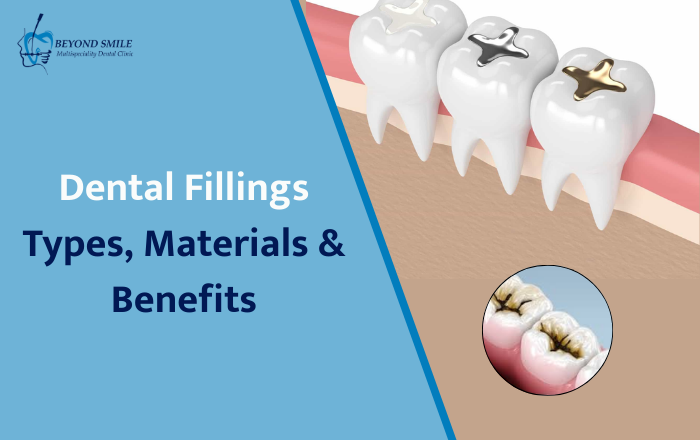Imagine biting into your favorite sweet and suddenly feeling a sharp twinge in your tooth. At first, you ignore it. But over the next few weeks, the pain keeps returning—especially when you drink something cold or hot. That’s usually when most people end up at the dentist, only to find out they need a dental filling.
If this sounds familiar, you’re not alone. Tooth decay is one of the most common dental problems worldwide. Studies show that more than 90% of adults experience cavities at some point in their lives. The good news is that dental fillings are a simple and effective solution. They not only fix the damage but also protect your tooth from further decay.
In this blog, we’ll break down everything you need to know: what dental fillings are, the different types and materials, how they work, and how to choose the right one for your needs. By the end, you’ll see why fillings are such an important part of keeping your smile healthy.
What Are Dental Fillings?
Dental fillings are materials used to restore teeth damaged by cavities, cracks, or minor injuries. When bacteria in your mouth feed on food particles, they produce acids that erode your tooth enamel. Over time, this erosion creates small holes called cavities.
If left untreated, cavities can grow deeper, reaching the inner layers of the tooth. That’s where pain, infection, and serious dental procedures like root canals often come in. A filling stops this cycle by sealing the hole, restoring the tooth’s strength, and preventing bacteria from spreading further.
In simple words: fillings close the gap and give your tooth a second chance to function normally.
When Do You Need a Dental Filling?
Not every toothache means you need a filling, but here are the most common signs:
- Tooth pain when chewing – especially when biting down on certain foods.
- Visible cavities or dark spots – a sign that decay has already begun.
- Sensitivity to hot, cold, or sweet foods – usually an early warning.
- Food getting stuck repeatedly in the same area of a tooth.
- Chipped or broken teeth from injury or grinding.
Think of these as early red flags. If you act quickly, a small filling can solve the issue. Ignore it, and you might be looking at a crown, root canal, or even extraction later.
Types of Dental Fillings
Different materials are used for dental fillings, and each comes with its own pros and cons. Here’s a closer look:
Amalgam Fillings (Silver Fillings)
- Durability: Lasts 10–15 years or more.
- Best for: Back teeth that need strength.
- Appearance: Noticeable silver color.
- Pros: Strong, affordable, resistant to wear.
- Cons: Not aesthetic, contains a small amount of mercury (though considered safe).
Composite Fillings (Tooth-Colored)
- Durability: 5–10 years.
- Best for: Front teeth or visible areas.
- Appearance: Matches natural tooth color.
- Pros: Blends in beautifully, bonds directly to the tooth.
- Cons: Shorter lifespan than metal fillings, may stain over time.
Ceramic Fillings (Porcelain)
- Durability: Around 15 years with good care.
- Best for: Visible teeth, especially in people who want a natural look.
- Appearance: Tooth-colored, resistant to staining.
- Pros: Very aesthetic, strong, long-lasting.
- Cons: More expensive than composite.
Gold Fillings
- Durability: 20+ years.
- Best for: Patients willing to invest in longevity.
- Appearance: Gold-colored, highly visible.
- Pros: Extremely durable, doesn’t corrode.
- Cons: Costly, requires more than one dental visit.
Glass Ionomer Fillings
- Durability: About 5 years.
- Best for: Children’s teeth or temporary fillings.
- Appearance: Tooth-colored but less natural than composite.
- Pros: Releases fluoride, which protects against decay.
- Cons: Not as strong, wears down faster.
How Dental Fillings Protect Your Teeth
Dental fillings are more than just “patchwork.” They actively protect your teeth in several ways:
- Stop decay in its tracks – once the cavity is cleaned and sealed, bacteria can’t spread further.
- Restore strength – fillings give back the structure lost to decay, so you can chew without pain.
- Prevent cracks – untreated cavities can weaken a tooth, making it prone to fractures.
- Save money and time – a small filling now prevents expensive treatments later.
- Keep your natural teeth longer – fillings protect your original tooth, reducing the chance of extraction.
In short, a filling acts like a shield. It blocks bacteria, strengthens your tooth, and preserves your smile.
How to Choose the Right Dental Filling Material
Choosing the right filling depends on a few key factors:
- Location of the cavity – back teeth need stronger materials, while front teeth need natural-looking ones.
- Budget – amalgam and composite are usually more affordable; ceramic and gold cost more.
- Aesthetic preference – if you don’t want anyone to notice, go for composite or ceramic.
- Lifestyle – coffee, tea, and smoking can stain some filling types faster.
- Dental history – if you’ve had frequent cavities, a fluoride-releasing option may help.
Here’s a simple comparison:
| Material | Durability | Appearance | Cost Level | Best For |
|---|---|---|---|---|
| Amalgam | 10–15 years | Silver/visible | Low | Back teeth |
| Composite | 5–10 years | Tooth-colored | Medium | Front/visible teeth |
| Ceramic | ~15 years | Natural look | High | Visible teeth |
| Gold | 20+ years | Gold-colored | Very High | Patients wanting longevity |
| Glass Ionomer | ~5 years | Tooth-colored | Low | Children, temporary |
Your dentist will usually recommend the material that fits both your needs and your budget.
Frequently Asked Questions
Q1. How long do dental fillings last?
It depends on the material. Amalgam can last over a decade, gold can last more than 20 years, while composite usually lasts 5–10 years. Regular dental check-ups help extend their lifespan.
Q2. Does getting a filling hurt?
Not at all. The procedure is done under local anesthesia. You may feel slight sensitivity for a few days, but it usually fades quickly.
Q3. Can children get dental fillings?
Yes, fillings are common for children. Glass ionomer fillings are often used since they release fluoride and help protect against further decay.
Book Your Dental Filling Appointment in Ballygunge Today
Dental fillings are a simple yet powerful way to protect your teeth. They stop decay, restore strength, and save you from bigger dental problems down the road. Ignoring a cavity today often leads to pain and costly treatments tomorrow.
If you’re noticing tooth pain, sensitivity, or cavities, it’s best not to delay. If you’re in Ballygunge, visit Beyond Smile Dental Clinic, led by Dr. Ankit Saha. Known as the best dental clinic in Ballygunge for dental fillings, they provide safe and lasting treatments that help you smile with confidence again.
Book your appointment today and take the first step toward healthier teeth.

